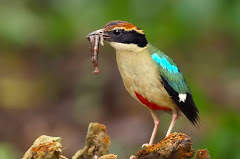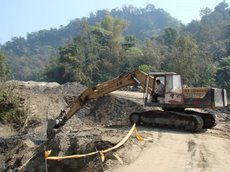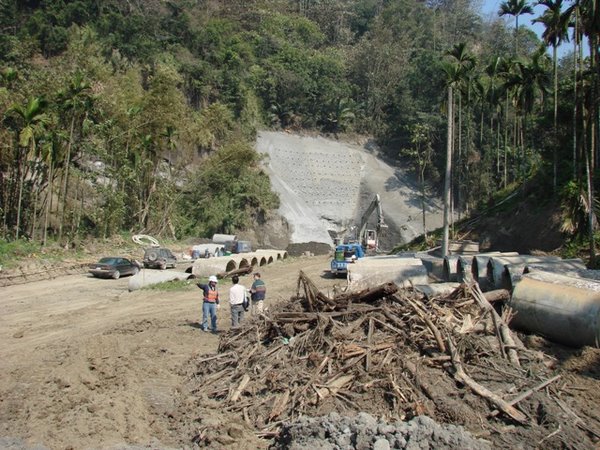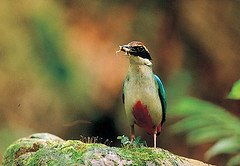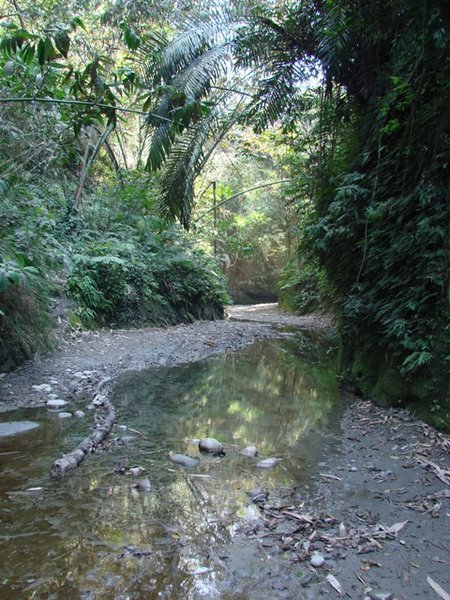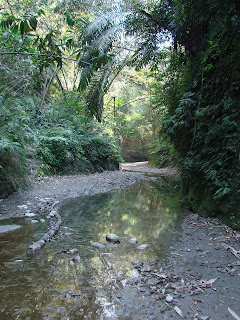
Hushan's Yucing valley before it was dug out to make way for the highly controversial Hushan Dam.
Yucing valley when the earth-movers got busy.
Pleasantries exchanged on the roadside. “Lunch?” “Yes, that would be lovely.” And so I found myself sitting down to dumplings in a typical Taiwanese dumpling joint making polite small talk. “See anything good at Augu this morning?” “No, it was very quiet. Not much around.” “Don’t know how you can spend so much time looking at those black and white waders. Hit the forests more. Colourful birds there and it’s so much prettier than the West Coast.” And then it happened! “Been to Huben lately?” “Yes, last week.” I feel my blood stirring. In an attempt to gain control of my run-away emotions I blurt out, “Saw two Pitta. Heard a Maroon Oriole.” And at that point the wave of anger held inside broke on the shores of my heart. “Huben’s fucked!” There was no disguising my feelings in the way I spat out those words.

Yucing valley being put to the grader.
All my intentions to remain calm and not to get emotional went out the window. I could see the look in his eyes; the judgment. He didn’t need to say anything. It was written all over his face. “Too much time in the sun. Irrational. Emotional. Unstable.”
And the forest is cleared to make way for the water demands of heavy industry.
So smooth. So controlled. And with calmness etched onto his face with perhaps just a hint of a condescending smirk he replied. “That bad? I don’t think it’s that bad. I mean it’s still a good birding spot.” I reply, “Compared to what it was, it’s finished; trashed!” “Oh, I don’t know about that.” And that level of anger within rocketed. “In 2006 there were forty pitta around the village. This year there are four! Four!!! In just six years forty to four. Huben is dead! Everywhere they’re doing the same. They’re concreting every bloody mountain stream they can. Before our eyes they’re destroying what’s left. On Saturday I saw those pitta and it struck me like a hammer. These are very likely the last of Huben’s pitta. What is a certainty is that my infant son will never enjoy seeing a pitta there by the time he’s six.”
Stripped and bleeding. The forest is no more.
My companion then continued calmly. He emphasized the need for a calm balanced approach and how he needed to find his niche in all this. I retorted, “The calm balanced approach has resulted in the loss of Huben. It hasn’t worked. Only when we say enough and get angry and take to the streets is there any hope of the destruction stopping.” For the first time the calm façade of Mr. Calmness showed a hint or irritation. “Taking to the streets has never helped anyone. It’s not going to save Huben.” Indignant I replied, “How would you know? It hasn’t been tried! It’s too late now. Huben is gone!”

Another stream disappears under concrete. Fairy Pitta nest on stream banks. This spot was a known Fairy Pitta nesting site.
I had had my say. Mr. Calmness wasn’t looking so calm anymore. It was written on his face. A change of topic. Dignity. A stiff upper lip was what was needed to selvage this most unfortunate lunch. I obliged.

Deforestation before our eyes. This happened just a few weeks ago.
Later as I reflected, I couldn’t help wondering if we’ve been so wired by our present environment and education system that even for people who clearly feel something for the natural world we have been so conditioned, programmed, to put the alleged need for what we’ve been taught is “progress” over that of the natural world. In the case of Huben it translates to, “I care about the Fairy Pitta but I mustn’t let that get in the way of progress.” We need to be honest and we need to reflect. What does Huben represent? Huben isn’t just about Fairy Pitta and a dam. It represents the choice of irreversibly proceeding with development of the petrochemical industry at the expense of Taiwan’s natural environment or halting the damage and turning towards a more sustainable future before it was too late. This was about the tipping point on the West Coast.

And more concrete for the rivers.
The first thing we need to do is acknowledge that we failed miserably in protecting the Huben-Hushan IBA (Important Bird Area). Huben is lost. At one point there were scores of NGOs under the umbrella of the Taiwan National Coalition against the Hushan Dam. How many remain today? The issue was very much about protecting the Fairy Pittas' globally most important breeding area. There were several other less prominent but equally important other threatened species residing in the Huben-Hushan IBA.
The reason for the construction of the Hushan Reservoir is largely to supply the water needs for the expansion of heavy industry on the West Coast. Considering the toll that heavy industry takes on the environment it begs the question, “Do we want to go on polluting at even greater levels than we are now?” Apart from the corporations that stand to make even more money in the short term is anyone else going to benefit at all from greater levels of pollution and the destruction of what remains of the natural environment? The Fairy Pitta and Co in Huben aren’t. The critically endangered Taiwan pink dolphins on the west coast aren’t. The farmers aren’t. The fishers aren’t. Our health isn’t. So then why the hell are we doing this then? Because of so called “development!” Because despite all the damage that we know is going to take place we have been conditioned to allow corporations to do whatever they like to make a quick buck.
So what went wrong? Why have we allowed this? We need to ask these questions. Those scores of NGOs need to look at where we went wrong and how this was allowed to happen. If we fail to do that then not only have we allowed Huben to be lost but then we have also gone and spat on its grave and that of the entire West Coast. Our only redemption is to learn from this. If we don’t then we have failed our children and future generations of Taiwan, human and nonhuman, utterly and entirely.

A Huben Fairy Pitta.












